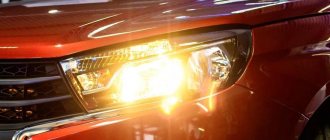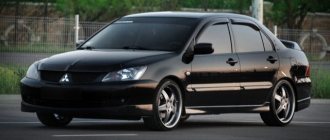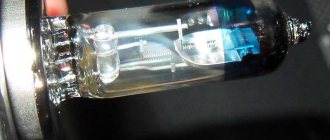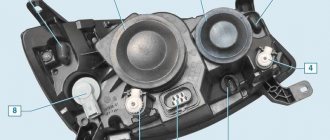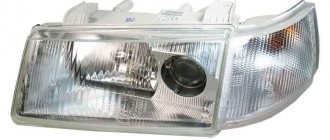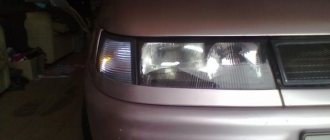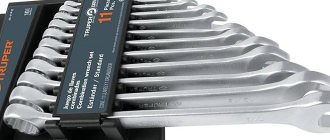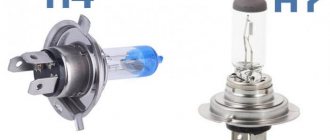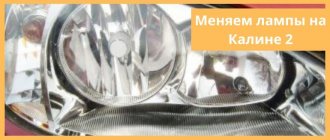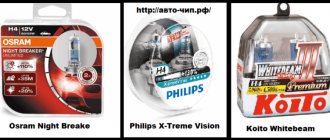Taking into account recent changes in traffic rules in the Russian Federation, the driver is required to turn on low beam headlights both when driving in the dark and during daylight hours. Otherwise, traffic police officers have the right to fine the driver.
Although the amount of the fine is not the largest, the very fact that a car can be detained for violating traffic rules, after which the driver will be fined a certain amount for such an offense, is, for a number of reasons, unacceptable for most responsible motorists.
Naturally, in the current situation, many car owners are faced with the fact that the human factor in practice turned out to be the main reason why a car without the lights on is stopped and fined. In simple words, drivers often simply forget to turn on their headlights.
To avoid such errors, the best option is to turn on the low beam when starting the engine, that is, automatically. However, not all vehicles have a similar function, which is implemented as standard. In this article we will look at how to modify a car so that the headlights turn on simultaneously with the start of the internal combustion engine.
Pro Tips
Of course, drivers who have at least basic training in electrical engineering and experience in doing this kind of work with their own hands can do the job efficiently with their own hands.
Professionals also advise that before starting work, you should really assess your capabilities. In some cases, in order to avoid problems, it is better to fork out some money and entrust the work to a professional auto electrician.
If the work will be done independently, then it is recommended to arrange all tie-in points inside the cabin. At the very least, they will be protected from the negative effects of precipitation.
It is more rational to make the connection points themselves by twisting the wires - this method is in no way inferior to soldering, and in conditions of increased vibration it turns out to be more resistant to loads.
The installation should not be carried out in such a way that, with the maximum permissible trajectory of movement of the wiring branches, their tension does not arise; all bending points of the wiring located near the metal fragments of the body must be protected using a polyvinyl chloride tube.
It is not advisable to follow the recommendations of amateurs who claim that to obtain the desired result, you can install a jumper in a certain place on the car's mounting block, without installing an additional relay. Failure to comply with basic electrical engineering rules is a real cause of serious problems, for example, headlights may turn on bypassing the fuse.
Carrying out installation work with your own hands will require maximum care and accuracy from the car owner. During operation, the possibility of moisture and mechanical deforming loads on system fragments should be excluded. It is not recommended to use gas-discharge lamps in automobile electrical systems.
If you are afraid to use homemade versions of Eurolight connection devices, you can install devices made in the factory, for example AvtoSvet AS, PHARAON, Skybrake M5, Meguna T 7.2, etc.
Connection errors
To avoid problems, you need to take into account the main mistakes and avoid them:
- Poor contact of connections. You should not make twists and wrap them with electrical tape, this is a short-lived option.
Connecting headlights via a relay is not difficult, since everything you need is sold in car dealerships, and the circuit is very simple. The main thing is to ensure reliable contact of connections and lay the wiring carefully so that it is not damaged during operation.
Benefits of installing the system
First, we will look at the main advantages that using automatic light switching options gives us:
| Convenience | Now you will not forget to turn on the lights, and you will not be fined by the traffic police. As practice shows, the majority of such offenses are committed precisely because drivers forget to turn on the lights when starting to drive. In addition, you will not have to be distracted, you will know that the system works automatically at a certain point in time |
| Battery preservation | As practice shows, very often after finishing driving, drivers forget to turn off the lights, as a result of which the battery runs out; if such cases are repeated periodically, the battery will fail very quickly. The presence of such a system allows you to eliminate such troubles, because the shutdown will also be carried out automatically |
| Ease of work | You can easily implement any of the options described below with your own hands; the installation instructions are simple and clear, so you can do it without outside help, especially since the delivery set includes all the elements necessary for installation. The main thing is to be careful and use only high-quality connection methods; twisting and electrical tape are unacceptable |
| Low costs | The price of the required elements is low, so you will not incur large expenses. The most important thing is to choose a high-quality option that will ensure good system operation |
The automatic low beam headlight switch in some models requires moving the regulator to a special mode, sometimes it is marked with the letter “A”
Recent Entries
Potentiometer R3 is used for fine tuning so that the machine responds to an input voltage in the range of 13.2...13.3. In some countries, it is necessary to turn on the headlights when the vehicle is moving. True, not everyone likes this method, since such a scheme requires pulling wires and making connections much more difficult. I remembered that in recent years many Schottky diodes have appeared, which are distinguished, in particular, by a smaller voltage drop and very high permissible forward currents.
You need to ask for powerful Schottky diodes in TO package
After the engine is turned off, the lighting turns off. Method 2: Connecting to the handbrake This method is much simpler, since in this case it is enough to just slightly modify the headlight connection diagram for ignition, which we talked about at the very beginning. Operation: when the ignition is turned on, the circuit goes into standby mode, and when moving, having received a signal from the DS, it turns on the light and relay K3, which has its contacts K3. In byte 18 we write the correct lighting circuit - The electrician did not have a diode so that the headlights would light up at the same time as the headlights turned on. In this case, the capacitor included in the headlight control unit will begin to discharge, and power will not be supplied to the relay. I want to share the diagrams and some nuances. How to make your car's high beams brighter
Automatic switching on of headlights via a pressure sensor.
In the third connection method, automatic turning on of headlights, Kulibins suggest using an emergency engine oil pressure sensor. The connection diagram is identical to that described earlier, only the relay coil is connected not to the generator, but to the emergency oil pressure sensor. In this case, the headlights will light up immediately after pressure appears in the lubrication system. The disadvantage is that the headlights turn on regardless of the serviceability of the generator. When the oil pressure is low at idle, if the engine condition is not the best, the headlights will begin to flash when the sensor is triggered.
Only the simplest and possibly primitive ways of implementing automatic headlight switching are discussed here. On the Internet you can find many more schemes, both simple and quite complex. Also in stores they can offer you ready-made blocks to implement this function.
admin06/06/2013
comments 2
Subscribe to comments
- Danik — January 22nd, 2015 at 9:29 am
Hello! On my Nissan Maxima there are two wires from the headlights, left and right, to the switch! Both via relay and power plus! What about the connection?!
admin — January 23rd, 2015 at 20:00
There are several headlight connection diagrams on the Nissan Maxima. Depends on the year of manufacture and configuration. But I didn’t come across any relays in the headlight switching circuit. A special feature of the circuit is the installation of a switch in the headlight circuit, between the fuse and the headlight lamp and having constant power, regardless of the ignition being turned on. Execution of the scheme depends on what you want to achieve. The simplest solution is to install a relay in the headlight circuit, the coil of which receives power when the ignition is turned on. In this case, you will have to install two of them on the fuse side. You can get by with one, but it will have to be placed on the minus side, which must be combined for both headlights. Answer
A comment
Name *
Website
This site uses Akismet to reduce spam. Find out how your comment data is processed.
« Popping noise when turning on the ignition of a VAZ
Battery Operation »
Tags
VAZ, VAZ malfunctions Sensors Ignition Injector Devices Starter Circuits Electric cars Power supply VAZ 2110 gazelle gazelle business recorders car repair
Recent Entries
- Laser headlights.
- Advantages and disadvantages of halogen lamps
- Design and principle of operation of parking sensors
- Multifunctional device Roadgid X7 Hybrid GT
- Malfunction of the GAS ignition system
Archives
Archives Select month September 2022 August 2022 July 2019 December 2022 August 2022 July 2022 June 2022 May 2022 April 2017 March 2022 December 2016 November 2016 October 2016 September 2016 August 2016 July 201 6 June 2016 May 2016 April 2016 March 2016 February 2016 November 2015 October 2015 August 2015 July 2015 June 2015 May 2015 April 2015 March 2015 February 2015 January 2015 December 2014 November 2014 October 2014 September 2014 August 2014 July 2014 June 2014 May 2014 April 201 4 February 2014 January 2014 December 2013 November 2013 October 2013 August 2013 June 2013 May 2013 March 2013 February 2013 January 2013 November 2012 October 2012 September 2012 August 2012 July 2012 June 2012 May 2012 April 2012 March 2012 February 2012 January 2012 December 2011 November 2011 October November 2011 September 2011 August 2011 July 2011 June 2011 May 2011 April 2011
- Accumulator battery
- Video
- Generator
- Sensors
- Diagnostics
- Ignition
- News
- Equipment
- Devices
- Repair
- Spark plug
- Starter
- Scheme
- Devices
- Electric cars
- Electricity supply
Automatic switching on of headlights upon ignition
In order to organize such operation of the lighting elements, it is necessary to connect them to the ignition power source, and as many know, some devices can be connected at any position of the ignition switch, while others begin to function only when the ignition is already on. Based on this, the most convenient place to connect the headlights is the heater switch button (the rightmost switch block).
For this scheme you will need:
- any standard five-pin relay;
- diode;
- wires.
This is interesting: Photo spies saw the successor to the Toyota Supra
We recommend: What types of carburetor cleaners are there and which one is better?
Next, we need:
- Remove the size switch (switch block on the leftmost side).
- Disconnect the positive wire from the key block responsible for the low beam operation (usually this is a green double wire) and connect it to the relay.
- You need to insert an additional wire into the positive wire that goes to the heater switch and also connect it to the relay.
- Connect the wire that powers the headlights to the relay.
- Throw the wiring to minus (to the body).
The connections can be soldered, but for full-fledged work, an ordinary insulated twist will suffice. As a result, automatic low beam headlights will work as soon as you turn on the ignition.
However, this method is considered not the most economical, since the headlights start working immediately, which is not very important in winter, when the engine needs to be warmed up or when repairing a car.
To avoid such inconveniences, you can complicate the circuit a little so that the low beam turns off while parked, regardless of whether the ignition is working or not.
The nuances of turning on running lights
From contact 85 K2 we make a connection to the pink-black wire coming from the HF handbrake. On most cars this is done during design at the manufacturer, and where it is not implemented it can be easily done.
As you can see, the problem is very relevant.
The switches that are available in stores for automating the switching on and off of the low beam have, in our opinion, the following drawback - they either react to the voltage level in the vehicle's on-board network, and in the classics the drawdowns can be very considerable due to the use of weak generators in stock. I decided to report.
The PTF lights came on, the circuit worked, everything is fine. There was no need to change the headlight bulbs.
Electrical circuit diagrams Lada Largus
First, you will need to dismantle the size switch; its location is the leftmost switch block. Such aspects need to be taken into account separately. Some car enthusiasts claim that it is possible to connect running lights without a stabilizer. Scheme two The above-mentioned problems can be prevented by slightly complicating the schemes.
The transistors included in the circuit will supply voltage to the relay, which will turn on the lighting fixtures. The position of the headlight stalk switch is any, the ignition is turned off “parking” - the low beam and dimensions are turned off. Operating principle: The ignition is turned off - there is no voltage on the relay and the headlights do not light up.
Recent comments
When the ignition is turned off, no electricity consumers were added from the on-board network. I have already installed this circuit on two cars: on the Niva and on the five there is a similar generator. We make sure that 12 volts appears on it when the reverse gear is turned on, cut the wire and connect the part that goes back to pin 12 of the t73b BCM connector. This is exactly the connection that we already cut when installing the backlight brightness control.
A higher resistance value means it will take longer for the lighting fixture to change status. This on-off switching continues for about 10 seconds, then some switch in the car clicks, not from our circuit, and everything falls into place. Connecting additional headlights via relay
Generator autostart circuit
All electrical appliances and equipment that require backup power are separately highlighted in the autostart diagram. The remaining consumers remain connected to the city network according to the standard scheme. The phase connection is carried out through an automatic fuse. The backup power consumers themselves are connected via a 32-amp outlet, which allows the full power of the generator to be removed.
The circuit must necessarily include a grounding loop to ensure protection and safe operation of the installation. Please note that the socket and autostart unit are not designed for high loads. The power of consumers connected to backup power cannot be higher than the rated power of the generator. In case of overload, there is a high probability of burning the winding and failure of the entire installation.
In some cases, the autostart circuit involves connecting voltage stabilizers. They are used for those consumers who are extremely demanding on the quality of electricity in domestic conditions and in production. The stabilizers are connected to the network in test mode. In case of stable operation of all consumers and absence of extraneous noise, the device is installed in front of the generator and connected to the city network. If the current supplied by the generator is of poor quality, then the stabilizer is installed after it and all consumers will receive an already stabilized current.
Turning on the headlights using the light sensor
Many foreign-made cars are equipped with special devices that turn the lights on and off without human intervention. Most often, such gadgets are combined with a solar light sensor in a car. If the controller realizes that it is dark outside, it turns on the headlights, and when it arrives at a lighter section of the road, it turns them off.
This is a very useful function for residents of some countries... But not for Russians. Traffic rules in Russia force drivers to turn on low beams (or daytime running lights) when driving at any time of the day and in any visibility.
Legislation [ edit | edit code ]
Scandinavian countries [edit | edit code ]
Daytime running lights were first used in the countries of the Scandinavian Peninsula, where natural light is insufficient throughout the day in winter. In 1977, widespread mandatory use of navigation lights was introduced in Sweden for the first time. At that time their function was called varselljus ("light of discernment" or "notifying lights"). These rules required the use of 21-watt lamps, similar to those used in brake or turn signals, emitting yellow or white light with an intensity of approximately 400-600 cd per axis. Daytime running lights were to be placed on the left and right edges of the front of the car. Finland adopted the use of daytime lights in 1972 on rural roads in winter, in 1982 on rural roads in summer, and in 1997 on all roads throughout the year; Norway in 1986, Iceland in 1988, and Denmark in 1990. To simplify compliance with the requirements, the use of low beam lights for marking purposes has been permitted. Taking into account the ECE, in these countries the use of lights with an intensity of 450 cd per axle is permitted.
How to connect daytime running lights?
Many motorists have wondered how to connect the DRLs so that they turn on when the engine is started. Garage craftsmen have found 10 ways to turn daytime lights on and off, as an example:
- From the handbrake;
- Battery;
- Instead of fog lights, etc.
And each of the methods requires money, as well as good knowledge of wiring diagrams.
Let's watch a video on how to install and connect daytime running lights via the control unit:
One of the main schemes is to connect the DRL via a 4-5 contact relay; some craftsmen connect the wires to the pressure sensor. Since when the engine starts, the pressure sensor on the dashboard automatically lights up, which means that when the DRLs are connected to it, the lights themselves light up.
We connect the DRL via a 5-pin relay
To work we will need:
- The relay itself, for example, from an alarm system;
- Several wires with a cross section of 4 mm;
- 3 male-female terminals;
- Daytime Running Lights;
- Heat shrink.
The first way to connect DRLs is as follows:
- Take the DRL and attach it where it is most convenient for you. We solder the negative wire to the body and secure it well. The positive wire is supplied with a “mother”, insulated with heat shrink and left for a while.
- In the car wiring you need to find the wire that goes to the low beam of any headlight. We connect to it, output it, solder the “mother” in the same way and forget about it for now. The same must be done with the positive ignition wire.
- Let's move on to the relay. It has 5 contacts, we will use all but 87. You can remove it or leave it, decide for yourself. Number 86 will need to be connected to the negative on the body, 85 will be connected to the headlight, 87a will be connected to the positive from the ignition. Contact number 30 is connected to the free DRL terminal. Assess the reliability of the insulation of the terminals on the relay so that there are no short circuits and the contact is good.
Another video, installing DRLs using a five-contact relay on a VAZ 2111, be sure to watch:
That's all, check your installation to see if it works. Turn on the engine and see how the daytime lights function. Then turn on the low beam, the lights should turn off. After turning off the lights, the DRLs should light up again, and after stopping the engine, they should go out. In order for the decay to occur smoothly, it is worth placing a good capacitor in the circuit in parallel.
Connecting DRL without relay
If you don't have a relay on hand, you can do without it. DRLs are very simple in electrical terms. At the output we have only two wires, red and black. By all rules, red is a “plus”, and black is a “minus”. Open the hood and look for a “+” on any of the car systems that starts when you turn the ignition key. As an example, these could be the wires going to the fuel sensor or any others. Connect the red DRL wire to the positive terminal of your chosen vehicle system. And connect the negative wire to another contact of the same charge.
The result of such a connection scheme will be that when the ignition is turned on, the DRLs light up, and when they are turned off, they go out. Be careful, after installing the lights, check the functionality of all electrical appliances. And do not drive on the road if there are any malfunctions in the car.
On the Internet you can find many other solutions on how to connect the DRLs so that they turn on when the engine starts. This article described only two of the most popular and less expensive methods. Other connection schemes require deeper intervention in the car’s electronics and the purchase of various materials and accessories. And, as you know, not everyone can understand intricate schemes.
New articles
- What is car clearance and how does it affect the car's performance?
- Fur car seat covers are a useful addition to your interior
Previous articles
- How to make wheel chains for a car with your own hands?
- What is engine chipping? Pros and cons of chip tuning
Automation options
It is quite possible to install an automatic switch and switch that will be responsible for the low beam with your own hands. But first you need to decide which method of implementing the scheme suits you best than the others.
There are 3 current options available:
- switching on when ignition is activated;
- Automatic switching on of the optics after starting the engine;
- using a special light sensor.
Each low beam automation scheme can be implemented in a garage. But if you do not have the necessary skills, doubt your capabilities, or simply want to get a guaranteed result, seek help from specialists.
Light sensor
On many foreign-made cars, the factory equipment already includes a special device that automatically turns the car's optics on and off. They work in tandem with a light sensor.
The device responds to changes in lighting levels. If the sensor detects darkening, the headlights turn on. When the car is on a bright section of the road, it automatically turns off. In many countries this function is very useful and convenient. But not quite suitable for the Russian Federation.
It's all about the requirement to constantly, day and night, drive with low beams or daytime running lights on. Therefore, in this situation, the operation of the sensor has to be adjusted.
Turning the low beam on and off should become a habit for drivers in the absence of an automation system. If you forget about the lighting before you start driving, you may be fined. If the automatic shutdown does not work or is simply absent, the turned on headlights on a parked car will drain the battery by the morning.
Drivers who cannot train themselves to turn lights on and off as needed are best off using an automation tool. One of them is considered a special sensor.
Motorists are offered the option of making the device themselves, or purchasing a branded device. Here we definitely need to stick to the second option. The following recognized companies offer automatic headlight switching and switching devices:
- Premier;
- Quatoom.
Most devices are based on a light sensor. And this, as you already remember, does not comply with the traffic rules in force in the Russian Federation. This is not a problem, since some devices are reconfigurable, allowing you to adapt them to slightly different work.
Light sensor
There is no need to describe in detail the nuances of installing a device with a light sensor. Each manufacturer completes its products with detailed instructions. They may differ from each other in the installation method. But in reality there is nothing complicated here.
Experienced drivers advise installing the light sensor not outside, but towards the interior, in the area of the rear view mirror, where it is usually located on cars with factory-made sensors.
Among the options presented, installing a sensor is considered the least practical and rational way to automate the switching on and off of optics. Yes, in certain situations the device greatly simplifies driving, since the driver does not have to be distracted by switches.
But at the same time, light sensors do not always adequately respond to the traffic situation. Some road sections can cause the controller to go crazy as dark areas quickly give way to light areas, and this happens constantly. As a result, the headlights turn on and off. It is unlikely that the traffic police will like this. And the driver himself will experience serious discomfort from such light and music.
Ignition
A good option for turning on the low beam automatically on a car involves using the ignition. The idea is for the headlights to turn on after the ignition is turned on.
To implement the circuit, you first need to connect the lighting fixtures to a power source. Since some devices are connected regardless of the position of the ignition switch, and others only after ignition, you need to choose the right source. The most preferable solution is a button to activate the stove.
To make the diagram work, you will need to take:
- set of wires;
- diodes;
- five-pin relay.
The kit is quite simple, and assembling everything you need will not be difficult.
After preliminary preparation, you can start working.
- The side light switch is removed. It is usually located on the leftmost switch block.
- The positive wire is removed from the button block, which is responsible for the operation of the car's near optics. On most cars this is a double green wire. It is then connected to the relay.
- The other positive wire that goes to the car heater switch is used to insert additional wiring into it. It also goes to the relay.
- A wire is connected to the relay through which the optics will be powered.
- The wire remains to be additionally thrown onto the body to make a minus.
Some additionally use soldering irons to improve the quality of the connection. But you don't have to do this. High-quality insulation using twisting and tape is quite suitable.
This scheme allows you to automate the process of starting the low beam as soon as the car’s ignition is turned on.
The automation scheme has certain disadvantages. The downside is the questionable cost-effectiveness of such a solution. The optics will start working as soon as you turn on the ignition. In winter, this function is of dubious benefit, since first you need to warm up the car for some time.
There is an option to avoid this drawback. But here we have to make the scheme even more complicated. The modification means that the low-beam headlights will turn off when the car is stationary. It doesn't matter whether the ignition works or not.
Engine
Those who are not satisfied with the option with a sensor and ignition can go a slightly different route.
You can use the engine start to turn on the low beam headlights automatically. Moreover, here the scheme is conditionally divided into 2 directions. They provide for connection to the handbrake or a sensor responsible for oil pressure.
Let's start with the connection option to the oil pressure sensor. To connect the circuit, you need to take:
- relay;
- a pair of transistors;
- wires;
- microcircuit K561TP1.
All components are installed in a compact relay housing. Next, the resulting device is connected to the oil pressure sensor. When the lubricant pressure in the power unit normalizes, which happens when the engine starts, the sensor will begin to open. The power going to it will go to the capacitor.
As a result, the voltage to our relay will go through the transistors connected to the power supply. When the engine turns off, power from the sensor goes to the necessary lamp, which is located on the vehicle’s dashboard. At this moment, the capacitor included in the optics control unit will discharge. This cuts off the power supply to the relay. The light goes out.
This scheme allows you to control the near optics in automatic and manual mode. To do this, you will need to use an additional parallel connection.
The driver can independently set the time to turn off or turn on the low beam headlights. To achieve what you want, you only need to select the optimal resistance on the board. The higher the value, the longer the time will pass before turning on and before turning off.
But this method does not suit all drivers. There are many opponents to such a scheme. This is due to the rather high complexity of the connection, which is objectively a fair remark. After all, here you have to pull the wiring and make about 3-4 connections. If you are happy with this option and you are ready to implement it yourself, you can get to work.
Why use the function of automatically turning on the headlights and parking lights in your car?
The ANV high beam control system is becoming increasingly popular among car owners. Recently, it has become mandatory for installation for vehicles with a permissible maximum weight of up to 3.5 tons. Its main function is to switch headlights from high beam to low beam and back in automatic mode.
It was created primarily for safer driving at night. And, I must say, it copes with its task excellently. Visibility is significantly improved, and the light of your car does not blind oncoming people. In addition, the driver is freed from the need to be distracted from the road, constantly changing the operating modes of the headlights.
In addition, in accordance with Russian legislation, driving during daylight hours with low beam or fog lights on is mandatory. Violation may result in a fine, so you must constantly ensure that your headlights are on correctly.
At the same time, light assist is not free from shortcomings. And first of all, it does not work correctly in the off-season, in particular in the fall. And it has arrived not only on the calendar. Fog, frost, rain – road users constantly encounter these atmospheric conditions that are uncomfortable for driving.
And it is precisely in such weather that the ANV system does not function correctly, or rather, it is not activated and does not work. This is due to a fundamental flaw in its design. As already mentioned, it works without problems in low light, in the dark.
Here's how it's implemented, say, in Toyota cars: (video)
This happens because the car has a light sensor. It is also called a twilight or light sensor. It consists of a photocell, a control unit and a relay. When a car enters a low-light area, say a tunnel, the system automatically turns on the high beams without distracting the driver.
However, the aforementioned signs, which are so characteristic of the Russian off-season, such as fog, snow or rain, do not affect the level of illumination. But the automatic lighting system does not define them as a change between light and dark or day and night. And as a result, despite the dangerously poor visibility, we are still driving with daytime running lights.
This shortcoming of the high beam control system has been known for a long time. However, drivers have already become accustomed to its convenience and sometimes forget about possible tricks on its part in certain weather conditions.
But such forgetfulness can be costly. And not only for you. What does it mean - the road is poorly lit, visibility has deteriorated, the lights don’t light up? Answer: you are not just invisible on the road. You simply do not exist for other road users. And when your presence is finally discovered, the consequences of such a “find” can be unpredictable. It's good if it's just a fine. What if there is an accident?
Therefore, we strongly recommend that car owners whose cars are equipped with light assist do not rely on the tricks of technology, but use common sense: visibility has become worse, air transparency has decreased - turn on the low beam.
And we turn it on ourselves, by hand. And it’s a good idea to add fog lights to it.
Tips and tricks
As you can see, self-made solutions can have more advantages than standard ones. The functionality is also expanding, and the cost is often more attractive. In other words, it is quite possible to assemble an inexpensive circuit for automatically turning on low beam headlights.
It is important to understand that to assemble a circuit with your own hands, you need certain experience and skills. If you are not confident in your abilities, it is better to seek help from a professional auto electrician.
If the work is carried out independently, it is optimal to place the insertion points in the interior space, and not under the hood. This approach will avoid oxidation of contacts, reduce the risks of moisture and short circuits, etc.
If we talk about what is better, soldering or twisting wires, correctly done twisting in some cases will be better than soldering in relation to a car. The fact is that the vehicle is subject to various vibrations, and soldering is less resistant to vibration loads.
As for relays, wires, fuses, etc., the relay must be securely fastened, the wiring must be laid so that the wires do not lie in tension. In places where wires are bent and at points where the wire touches metal parts of the body, additional insulating heat shrinkage must be present. Otherwise, the wire may fray and begin to short out.
It is also strongly not recommended to use regular jumpers instead of relays, connect bypassing fuses, etc. Ignoring these recommendations can not only cause equipment malfunctions, but also short circuits or fires.
- DIY engine start button
How does the engine start button work? Available options and solutions for installing the starter button yourself. How to install the engine start button yourself. Read more
- The radio turns off when starting the engine: reasons...
Why does the car's head unit (radio) turn off when the engine starts? The main reasons for turning off the car radio, possible malfunctions. Read more
- Engine demining: why is it?
What is the purpose of demining the power unit and why? The main advantages of this solution are installing additional mass yourself. Read more
- Do-it-yourself soundproofing of the engine compartment
How to properly make noise insulation of the engine and engine shield of a car yourself. Materials for processing, elimination of noise and vibration. Tips, recommendations. Read more
- On-board computer for carburetor engines: what...
On-board computer for a carburetor engine. The main functions and capabilities of the device, features of controlling the BC for carburetor cars, pros, cons. Read more
- Remote Engine Start Module
Remote engine start unit: basic functions. Safety of using the internal combustion engine autostart module, interaction with car alarms and immo. Read more
Overview of the main options and their features
We will look at how to automatically turn on the low beam in two ways, each of them has its own characteristics, and the choice ultimately depends on you.
Relay
Domestic manufacturers suggest using a special relay as a solution to the problem, its marking is 719.3777-01, with its help you can automatically turn on the low beam and side lights.
The following can be said about this option:
- The system is suitable for VAZs from the 4th to the 15th model, for example, the relay is installed for fog and regular headlights in the VAZ 2110, GAZ, UAZ and others, in which the low beam winding of the relay has a permanent connection to ground;
- The headlights light up approximately 5 seconds after the engine starts, which is very convenient, since, firstly, it makes it easier to start the engine, secondly, the load on the battery is significantly reduced, and thirdly, the life of the lamps increases;
- The lights turn off when the ignition is turned off, which is also very convenient, because now you won’t leave the car with the headlights on;
- If necessary, you can always turn off the light manually; to do this, the switch is flipped to the “low beam” position, and then placed in the “off” position.
This is what the kit in which this equipment variation should be supplied looks like
Now let’s look at how to implement automatic switching on of low beam headlights with your own hands; the work is carried out in the following sequence:
- First, you need to install a new unit instead of the low beam relay, and if you use mini-relays, you will need a special adapter, which should also be included in the kit, the whole process is as simple as possible and will not take much time;
Using the adapter, you can easily connect to the system, and the main relay needs to be mounted nearby in any place convenient for you
- In order to connect to the vehicle's power supply, the relay is provided with a wire with a contact; it must be connected to one of the fuses included in the kit. The option that suits your car is selected; it already has a connector for the wire that comes from the relay, so everything is done very quickly and reliably;
- The fuse is installed instead of one of the standard ones, and you need to choose the one to which “+” is constantly supplied after starting the engine, all the necessary information can be found in the instructions, if you don’t have it, then find the power fuse for the turn relay and install our unit in its place;
- As you know, in addition to the low beam, the dimensions and license plate illumination must be turned on; to implement this option, you need to connect the low beam and clearance wires of one of the headlights in the car via a diode (this unit is included in the kit);
- If your dimensions are not parallel, you will have to join the second headlight in the same way. The connection is made simply and quickly using connectors; the diagram below shows this process in detail;
As you can see, connecting to the standard system will not be difficult and will not require any alterations in the wiring
- In some models, the license plate illumination is switched on separately, in order to turn it on automatically, you need to use the same wire with a diode and connector to connect the low beam switch wire and the license plate illumination wire, below is an explanatory drawing.
The circuit for automatically turning on the low beam headlights and side lights is very simple
By going through this process, you will get a convenient and reliable system that will prevent many problems.
Important! On sale you can find similar second-generation designs, which are marked 719.3777-02; their main difference is the ability to install on any car, including models without a standard low-beam relay.
DRL module
The product has small dimensions, so it is easy to place it in any convenient place
This is a device for automatically turning on and off headlights, which can be installed on any vehicle with an on-board voltage from 12 to 24 Volts; its main advantages are the following:
- Possibility of installation on a car of any brand, you do not need to worry about whether this option is suitable for you;
- The standard connection diagram is not disrupted or damaged, therefore, if necessary, this control element can be removed without any consequences;
- You can configure the activation order at your discretion - either 15 seconds after starting the engine, or when the start sensor is triggered (the signal can be, for example, pressing the brake pedal);
- The kit includes all the required components, as well as instructions that discuss several connection options, depending on the specific wiring of the machine;
- The system may also include alternative daytime lighting options: additional headlights or fog lights.
Important! This option is especially suitable for cars with automatic start - now your headlights will not light up when the engine is running, the light will turn on when you press the brake pedal, which is very convenient.
This is what the device connection diagram looks like, everything is quite simple and clear
As for the connection, a very clear sketch is presented above, according to which the work should be carried out, in addition, the instructions describe all the actions in great detail. If you do not have experience in carrying out the work, then it is better to use the help of specialists, since an incorrect connection will cause system malfunctions.
The workflow goes like this:
- First, the device is connected to a light switch installed in the cabin;
- The black wire is used to connect to ground in any place convenient for you, the main thing is that there is good contact with the metal at the connection;
- The red wire must be connected to the ignition;
- The yellow and black version is required to supply power to the device;
- Next, you should connect to the speed sensor; to avoid problems, you should make the contacts as reliable as possible and properly protect them from moisture and dirt.
The location of all the elements is shown in the photo below; such a cheat sheet should be on the packaging of each product.
Pay attention to the note below - if you do not have a speed sensor, the jumper must be cut
There are many options for such control systems on the market, and it is important to choose a quality product, so you should not save on this device. In fact, there is nothing difficult in the work, and if you cope with the work, you can further improve your car.
For example, a system for automatically switching high beams to low beams allows you to create adaptive light that will be adjusted depending on the lighting conditions: when approaching oncoming traffic or entering an intersection. The diagram is presented below, but to implement it, you will need certain knowledge and skills.
The main element in this device is the photosensor.
In some models, you can enable DRL by flashing the on-board computer, for example, knowing the option codes for the automatic low beam of the BMW E39, you can enable this function, but it is better to contact specialists to carry out this work.
Lada 2107 › Logbook › Automatic switching on of low beam headlights after starting the engine.
After the last car (Subaru Forester SF5), in which the headlights turned on and off when the engine was started, I had to get used to pressing the button every time before driving. In just over a month of owning the 7, there have already been times when I turned on the headlights several times I forgot, fortunately I didn’t get a fine. It was decided to make small modifications to the car in order to automate the inclusion of low beam headlights. There are quite a lot of different options on the Internet for obtaining this effect, both homemade and factory goodies. Since it’s more interesting to do everything yourself, I decided to assemble a simple circuit using relays. For myself, I decided that my light should turn on only after the engine starts, not to disrupt the operation of the standard circuit, and so that when I turn on the light through the standard button, my “circuit” should be disassembled. To implement this task, the following were purchased: 1) 4-pin relay - 1 piece 2) 5-pin relay - 2 pieces 3) 4-pin relay block. — 1 piece4) relay block 5 pins. — 2 pcs. 5) holder for fork fuse 6) wires, corrugation, electrical tape Most likely there will be those who will say that it could have been done simpler, that three relays are a lot and could have been connected differently, but for me the circuit I came up with is simpler and more convenient. Naturally, I do not claim that this is exactly how this modification should be carried out)
The principle of operation and the role of each relay.1) The first relay is connected by contact 30 through a fuse to the battery. One contact of the coil is to the ground, the other is to the 15th contact of the ignition switch, the 87th contact is connected to the 30th contact of the second relay. 2) The second relay with the 30th contact, as already written above for the first relay, one contact of the coil is to the 15th contact of the ignition switch, the second end of the coil to oil pressure sensor. Contact 87A is connected to the 30th contact of the third relay. 87 The contact of the second relay is not connected to anything. 3) The third relay with its 30th contact is to contact 87A of the second relay, one contact of the coil is to ground, the second is to 12V from the size. Contact 87A is connected to the standard relay for turning on the low beam headlights, namely to contact 85 (if I'm not mistaken).
As a result, after turning the key to the “ignition” position, the first relay transmits voltage from the battery to the second relay. The second relay, until the engine is started and there is ground on the oil pressure sensor, opens contacts 30 and 87A, thereby not passing 12V to the 30th contact of the third relay. After starting the engine and increasing the oil pressure, the ground on the oil pressure sensor disappears and contacts 30 and 87A of the second relay close again. The third relay transmits voltage to the standard low beam headlight relay until the low beam headlights are turned on with the standard button, which is in the first position 12V is supplied to the dimensions, as a result of which the third relay opens contacts 30 and 87A.
When connecting to a standard relay, I decided to put a diode in the gap of the standard wire, which I took from an old PC power supply. Maybe it was unnecessary, but it makes me feel better =D
Connection points. 1) 15th contact of the ignition switch, on which 12V appears when the key is turned to the “ignition” position. Blue wire (double thicker and thinner). 2) Oil pressure sensor. The connection to it was made in the engine compartment. 3) Connection to 12V dimensions. For the left headlight, this is a yellow wire going to the headlight unit in the engine compartment, directly next to the headlight unit itself. 4) Connection to the standard low beam headlight relay. Gray wire with a red stripe Block Ш1 (black) going to the fuse and relay block under the hood. You can access this wire only from the interior by disassembling the control panel.
Do-it-yourself automatic low-beam headlight switching
As you know, low beams must be turned on when driving a vehicle, not only in the evening and at night, but also during the day. In a situation where the running lights do not work, the traffic police officer has the right to issue a fine to the driver. Of course, this is a small amount, but it creates a headache. In this regard, most motorists have encountered a number of inconveniences due to the fact that many simply forget to turn on the low beams when getting into the car, or do not turn off the lights when leaving the car, which is why they find the battery completely discharged in the morning.
In order to get rid of such problems, many decide to modify the process of turning on and off the headlights. Thanks to the simplest circuits, the headlights can turn on simultaneously with the ignition or when the engine starts. In this case, during the daytime the low beam headlights will light up, but not the headlights, and at night everything will work as usual. Let's consider both options.
Ways to solve the problem
To eliminate the problem, it is enough to reduce the power that is dissipated during startup. To do this, it is necessary to reduce the current in this circuit. There are several ways to solve the problem:
- A fairly powerful field-effect transistor with a capacitor on the gate. The transistor initially passes a small amount of current. At the same time, its capacitor is gradually charged, opening the shutter. With a fully charged capacitor, the power goes entirely to the lamp, eliminating the need for a relay. The disadvantage of the scheme can be considered the need to remove a large amount of heat;
- with an NTS thermistor and relay
works similarly . In the case of a car, it is better to use a 2-5 ohm thermistor. It is connected in series to the lamp. At the same time, it dissipates part of the power. As the thermistor gradually heats up, it reduces its resistance. The power on the light bulb increases when this indicator reaches a certain level; a relay connected in parallel with the lamp disconnects the thermistor from the circuit, providing the lamp with maximum voltage; - Pulse width modulation
. Unlike those described above, this method does not limit the current, which reduces power dissipation. This reduces the need for cooling. The circuit uses a field effect transistor. Through it, voltage is not supplied to the light bulb constantly, but with pulses of several microseconds. Thanks to this, the coil heats up evenly. And the headlights gradually turn on.
Automatic switching on of headlights upon ignition
In order to organize such operation of the lighting elements, it is necessary to connect them to the ignition power source, and as many know, some devices can be connected at any position of the ignition switch, while others begin to function only when the ignition is already on. Based on this, the most convenient place to connect the headlights is the heater switch button (the rightmost switch block).
For this scheme you will need:
- any standard five-pin relay;
- diode;
- wires.
Next, we need:
- Remove the size switch (switch block on the leftmost side).
- Disconnect the positive wire from the key block responsible for the low beam operation (usually this is a green double wire) and connect it to the relay.
- You need to insert an additional wire into the positive wire that goes to the heater switch and also connect it to the relay.
- Connect the wire that powers the headlights to the relay.
- Throw the wiring to minus (to the body).
Light sensor failure
As a rule, such devices rarely break down on their own. Provided that you have chosen a quality product from a well-known brand. When it comes to safety while driving, there is no need to skimp. Breakdowns are usually caused by factory defects, improper installation or improper use. It often happens that it takes many hours to find a fault, but the repair itself takes only a few minutes.
Many manufacturers indicate some restrictions for their products, so you should carefully read the instructions
As a rule, these are standard precautions: make sure that no moisture gets inside the device elements, protect them from mechanical and other influences. There are also sometimes recommendations not to use gas-discharge lamps on cars.
